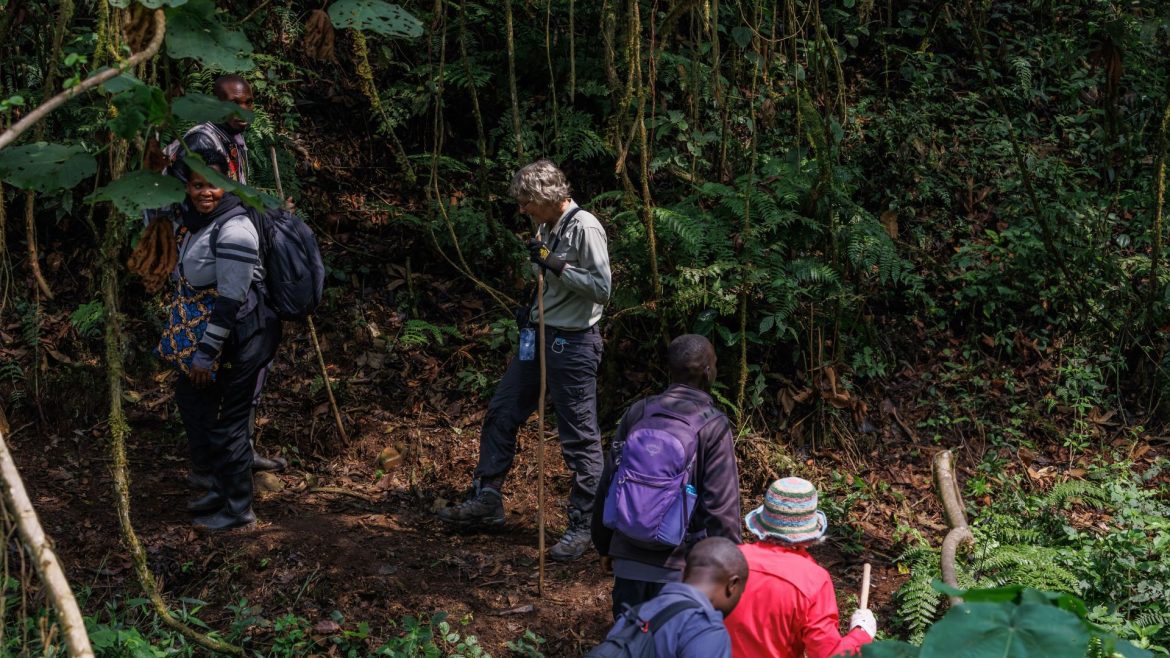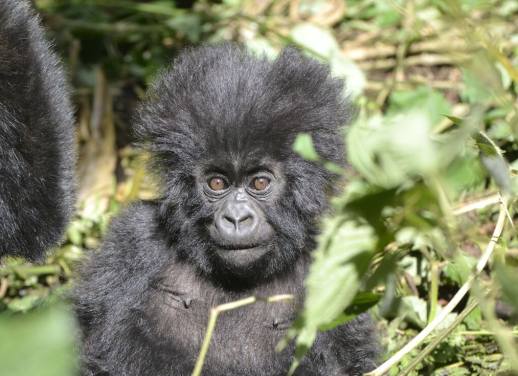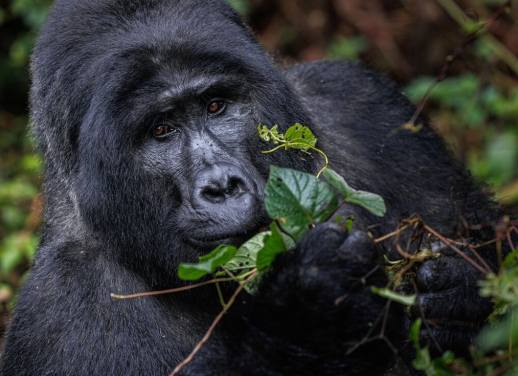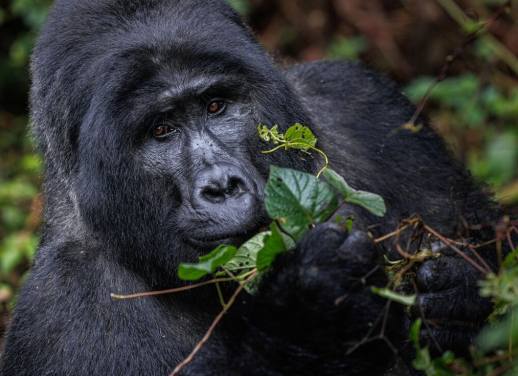Follow in Susan’s footsteps as she pulls back the curtain of Bwindi Impenetrable National Park in Uganda to give you a glimpse of meeting great apes in their natural habitat.
I wished I’d gotten a good night’s sleep, but honestly, I was too excited. I woke up well before my 5:30 am alarm. Instead of staring at the ceiling, I got dressed, grabbing the lightweight long-sleeved top and full-length pants I laid out before bed. Since mud, nettles, thorns and fire ants were a real possibility, my ensemble also included ankle-high hiking boots, gaiters and a pair of gardening gloves at the ready. As it turned out, I needed it all.
Taking out my collapsible waterproof backpack, I checked my gear for the 18th time: baseball cap, rain pants and rain jacket. Check. Refillable water bottle, sunglasses and sunscreen. Check. American dollars for tips. Check. My camera, lens, phone, extra batteries and memory cards. Check. And last but not least, a surgical mask. With an uptick in respiratory illness among the gorillas, all visitors must wear them.
I was good to go.
Seeing a gorilla may take as little as three hours or as many as six.
Gorilla trekking is a thrilling adventure, but it’s not for everyone. Seeing a gorilla may take as little as three hours or as many as six, though that’s rare. You’ll climb steep, mud-slicked hills and battle dense foliage at altitude, making it hard to catch your breath. Not to mention, there’s a good chance it will rain. Because rainforest.
Even so, I promise that if spending an hour with one of the world’s most remote and fascinating creatures appeals to you, the memories you make will far outweigh the challenges of the moment. And while every trek is a unique experience, here’s a sneak peek at what to expect.
6:30 am
After devouring a light breakfast of eggs and toast, we, a gang of nine international travellers, were on our way to Bwindi Impenetrable Forest National Park, home to many of Uganda’s habituated gorillas – meaning they are so used to humans they behave naturally. To get there by 8 am, we hurried out the door at 6:30, grabbing a packed lunch from the hotel in case we were still in the woods when we got hungry.
The rocky, winding road to Bwindi might as well have been one giant pothole. Our Intrepid leader, Abdul, called the body-slamming ride an ‘African massage.’ It’s not quite what I’d call it, but the surrounding panorama of broccoli mountain peaks in a sea of fluffy silver clouds made up for it.
8 am
Arriving at our destination, we made our way to an open-air pavilion where park staff gathered around a large wooden table and a map. Earlier that morning, trackers had located the gorilla families to be visited. Assigning them to each group of trekkers was the next step.
Luke – one of the park’s guides – welcomed everyone and played emcee. He introduced members of the local Batwa people, one of the oldest surviving indigenous tribes in Africa, who shared a few of their traditional songs and dances. Many Batwa people, Luke noted, had grandparents who lived in Bwindi before the government established the national park in 1991.
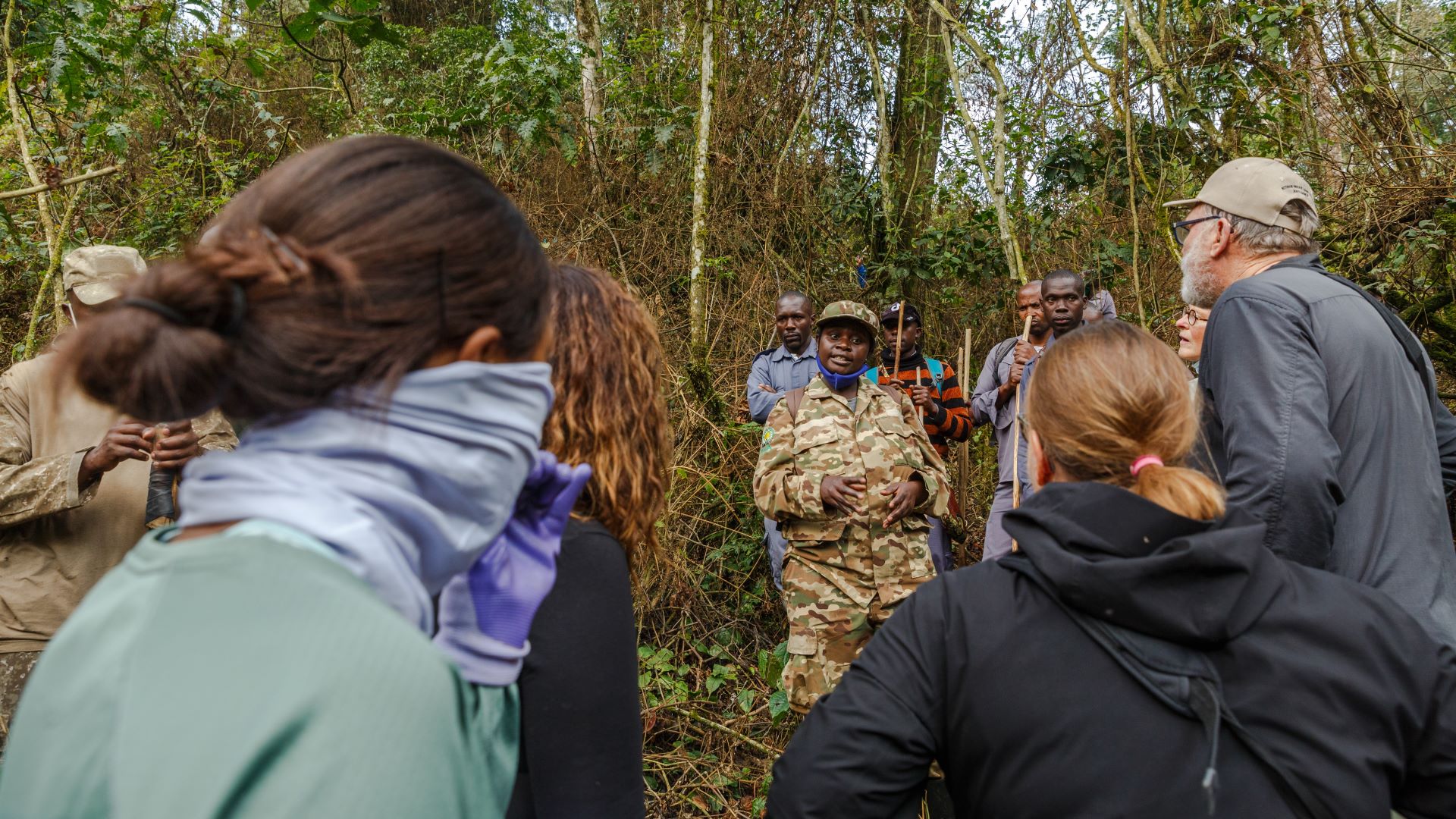
8:45 am
Dressed in camouflage from head to toe, our lead guide, Gloria, a 10-year veteran of the park, gathered us together for a quick rundown of the dos and don’ts of our trek. Do listen to your guides, and don’t run from a gorilla seemed wise advice. Our task was to find the seven-gorilla Mishaya family. Once spotted, we would have 60 minutes to take photos and marvel.
However, we needed to wait for our African helicopter before we could be on our way. As with the African massage, it had nothing to do with what the name suggests.
The previous night, Roger, one of the travellers on my trip, told us his asthma had worsened, and he didn’t think he could manage the trek. Though he put on a brave face, his disappointment oozed from every pore.
We were all heartbroken for him. The trek was the centrepiece of our trip. Thankfully, Abdul had a solution. He had arranged for an ‘African helicopter’. Roughly translated, it was a chair-like contraption placed on the shoulders of 18 porters who would carry Roger’s 1.96-metre, 108-kilo body up the mountain. Problem solved.
Anxious to be on our way, Gloria asked us to wait a few seconds longer, explaining that Roger and the porters would walk ahead. Once Roger had settled, Gloria added, ‘they will walk faster than us.’
‘What? That seems unlikely,’ I thought. But to my amazement, the nimble crew whisked Roger up the mountain like they were on an escalator.
We saw the silverback a few meters further in, facing away from us. My heart leapt.
Dropping in behind them, Gloria led us single file under a bright blue sky into the vast jungle. Rangers at the front and back of the line sported rifles in the unlikely event they might be needed. My porter, a Batwa named Doce, a sweet, mild-mannered twenty-something who lived in the area, carried my gear. Did I need a porter? Not really. I’m in pretty good shape.
Nevertheless, there were a few reasons I was more than happy to spend the $20 USD to hire him. One, hiking over rough terrain is much easier when someone else helps carry your gear. Two, when things got tricky, Doce held my hand, walking across slippery logs. And on a steep incline, he kept me from losing my footing on the muddy slopes. Third, and the most compelling reason was the ability to support the local community directly.
Opportunities for employment are limited in the region, and jobs as porters are in high demand. For everyone to have a chance, each porter is allocated one day a month. Though Roger would have preferred to be able to trek on his own with one porter, needing assistance enabled 17 additional people to work that day.
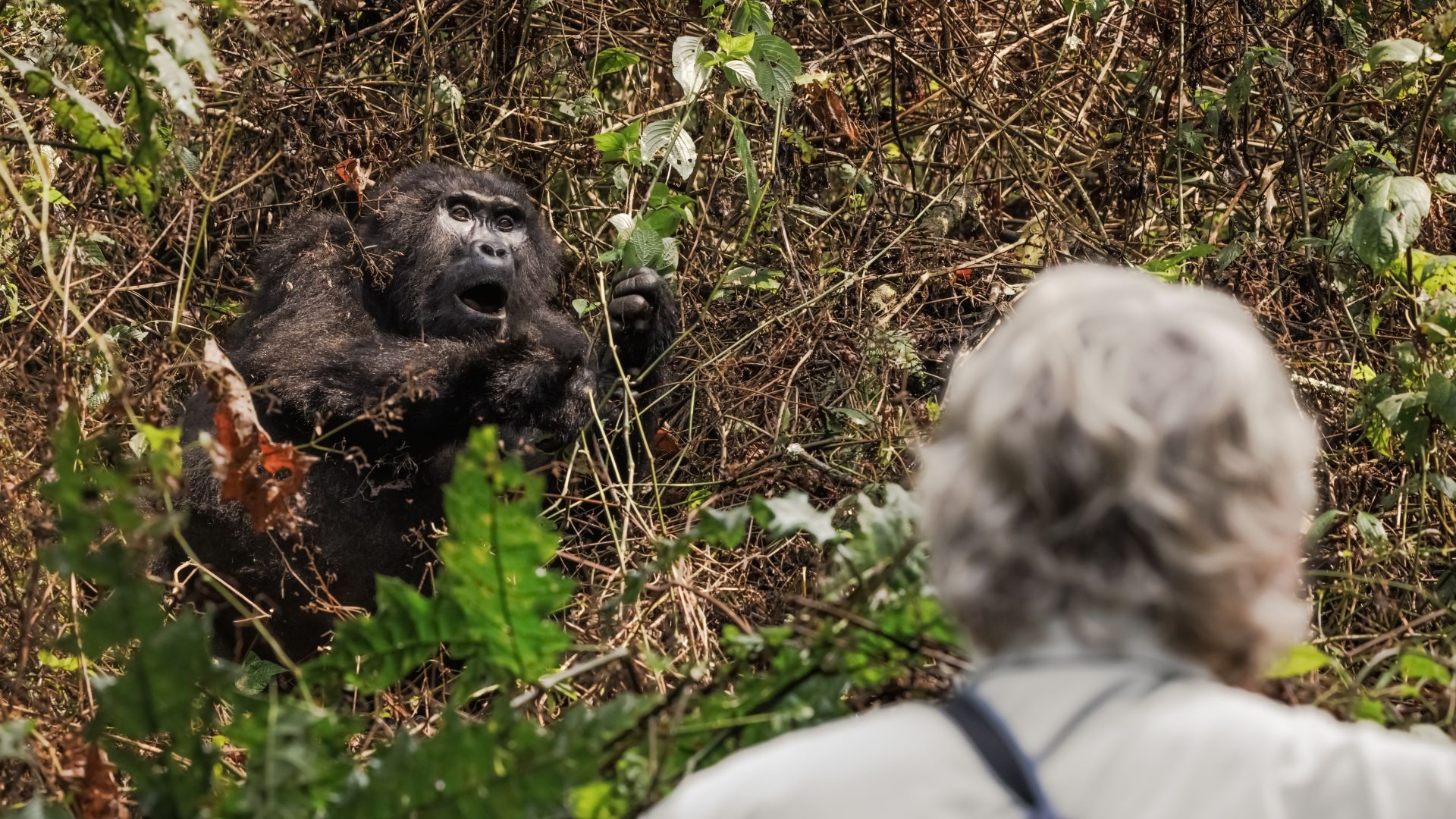
9:45 am
Gloria paused. ’I just saw the silverback,’ she said. What? I looked around and saw nothing. Two trackers monitoring the Mishayas all morning emerged from the trees. ‘From now on, you must wear your masks,’ she said.
We saw the silverback a few meters further in, facing away from us. My heart leapt. His name was Tinfayo, which means ‘I don’t care.’ He was huge! I mean, I knew they were big, but wow. He moved into the bushes, and the trackers urged us forward. Our porters stayed behind to keep the numbers around the gorillas at a minimum.
The machete-wielding trackers cleared a path to follow their trail through virgin forest. It wasn’t long before we saw the alpha again chewing on juicy green leaves.
In a flash, he got up and moved toward me. I wasn’t sure if I was supposed to get out of his way or stand still. The answer came quickly. ‘Don’t move,’ said one of the trackers. Tinfayo passed me so closely I could have patted him on his back but thought better of it. I was giddy with excitement. We all were.
Reminding us that we only had 60 minutes before leaving, Gloria officially started the clock on our encounter with our great ape cousins.
Trackers serving as hosts pointed out other members of the troop. A baby sat with its mother among some vines. A female under a tree nursed an infant. Another female was relishing a bush. The trackers also helped to make the most of our experience by chopping small branches obstructing our view and, more than once, taking us by the hand to bring us closer and place us at better angles to take photos.
Tinfayo and the other gorillas paid us little mind except for one darling 13-month-old, who made it clear she found us as exciting as we found her. She was heart-popping adorable, rolling in leaves, beating her tiny chest, mugging for the camera and dangling from limbs with playful intensity.
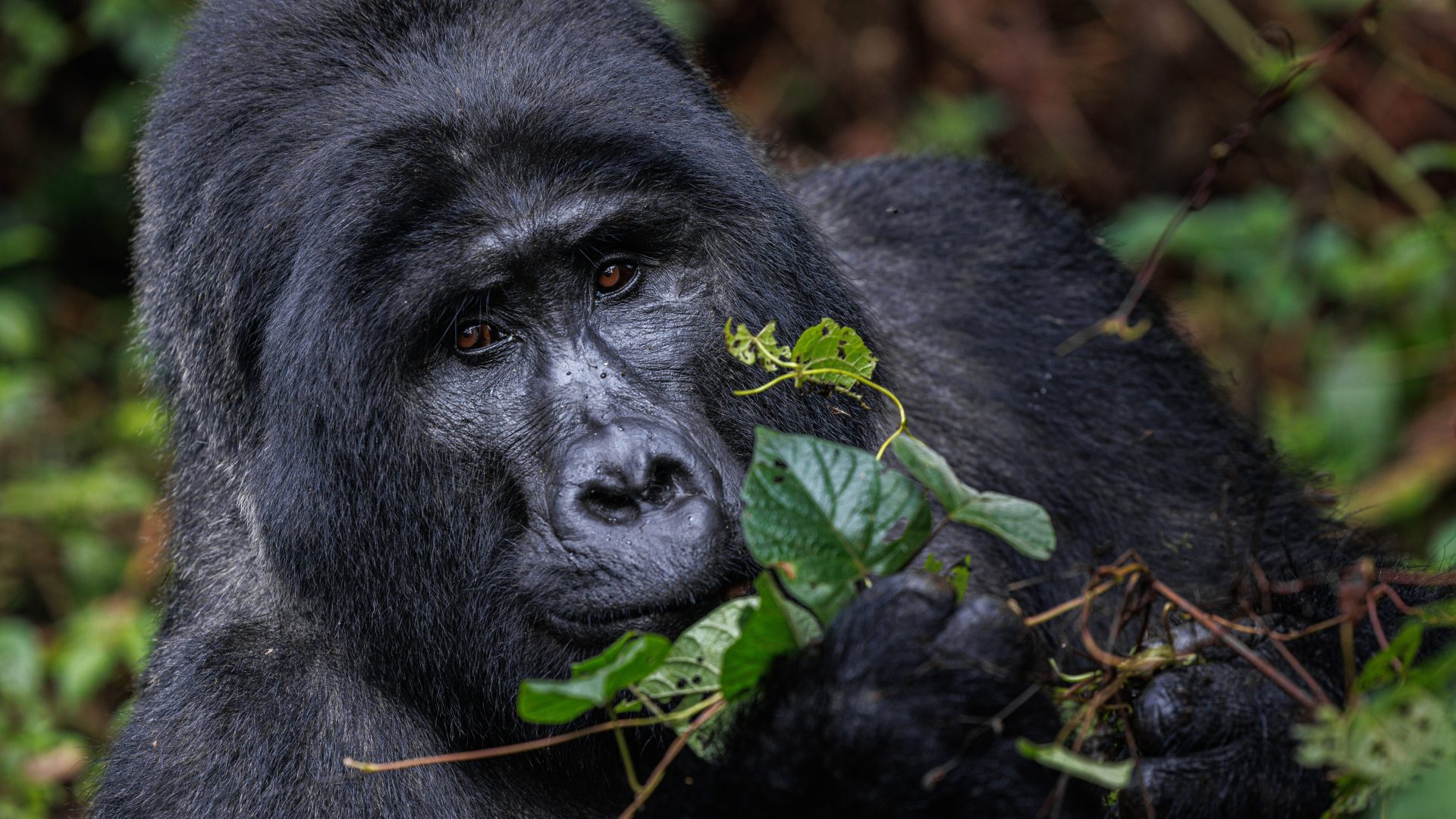
11 am
‘Times up!’ Announced Gloria. Our hour was over all too quickly. As is the case with most unforgettable experiences, time flew by.
We tipped our trackers, who stayed with the gorillas until they made their night nest so they would have a point of reference to find them the next morning, and we returned to the pavilion. We were the first and only group to have returned. We tipped Gloria and our porters and were given a Gorilla Tracking Certificate as a memento of our experience. The entire excursion took about 3.5 hours.
12:30 pm
After snacking on our brown bag lunches, we shopped at several cash-only souvenir stands at the entrance to the park. Just as we finished, sheets of rain fell from the sky. Jumping into our vehicle, we felt sorry for the people still trekking and oh so happy we were not with them. The park staff ensured the porters didn’t have to carry Roger too far, and the Mishaya troop was the closest gorilla group to the pavilion. Watching the rain create rivers on the road, we celebrated our delightful twist of fate thanks to Roger.
Read more about Susan’s experience in Rwanda and Uganda. Find your own small group trekking adventure with Uganda and Rwanda’s great apes.
All images by Susan Portnoy.

